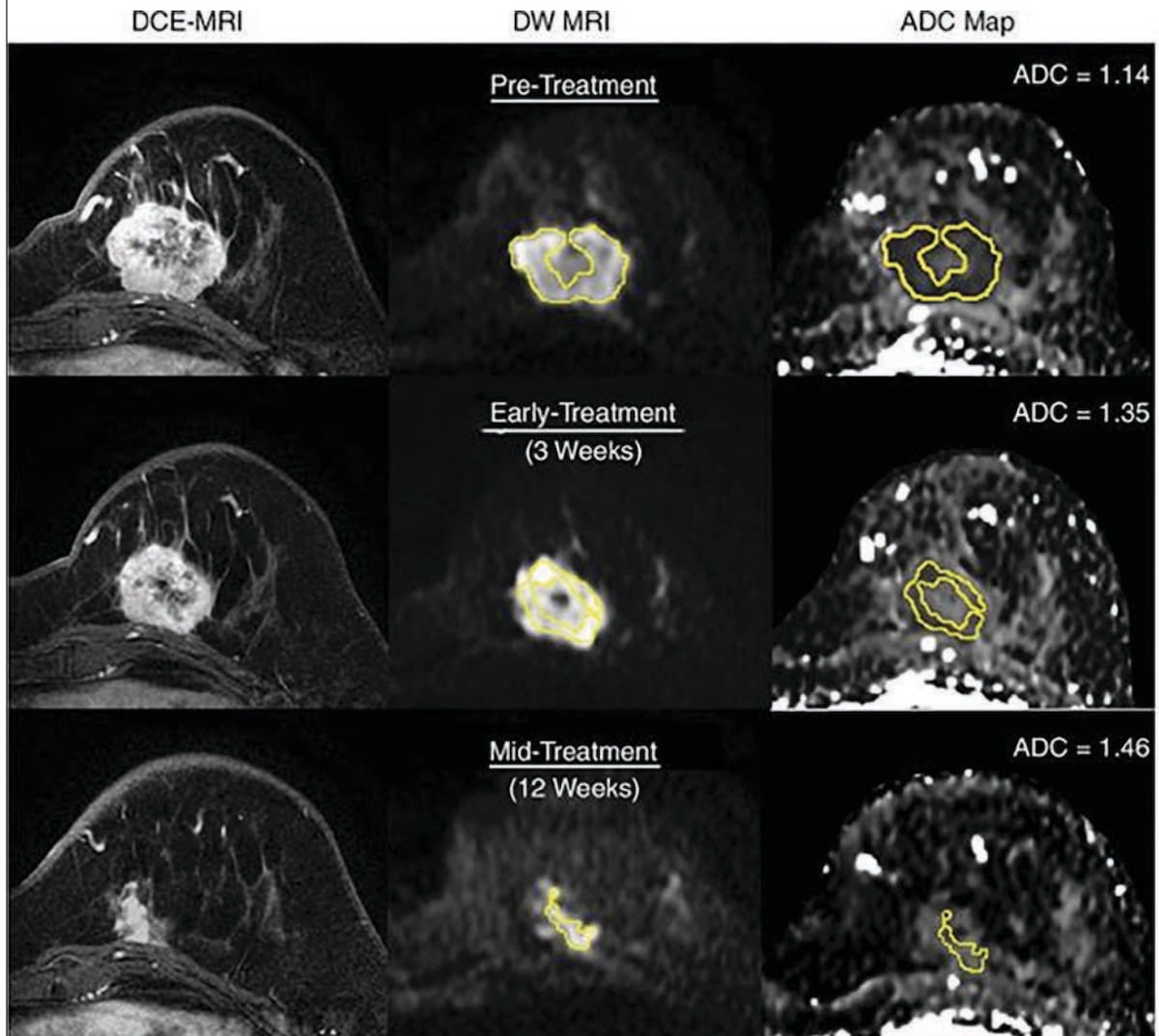Can DWI MRI Offer a Viable Non-Contrast Alternative for Breast Cancer Assessment?
In a newly published literature review, researchers examined the benefits of diffusion-weighted imaging (DWI) magnetic resonance imaging (MRI) for breast cancer characterization and monitoring of neoadjuvant chemotherapy, current drawbacks that thwart wider adoption, and emerging techniques that may enhance the modality’s effectiveness.
Noting the increasing use of diffusion-weighted imaging (DWI) in supplemental breast magnetic resonance imaging (MRI) examinations, researchers recently published a literature review examining the strengths of the modality, weaknesses with respect to false negatives and variable acquisition methods, and newer techniques that may help address commonly cited limitations.
Here are nine takeaways from the recently published review in the American Journal of Roentgenology.
1. Noting the benefits of DWI for visualizing breast tissue microstructure, the review authors emphasized that apparent diffusion coefficient (ADC) assessment with DWI can be a key factor in breast cancer characterization. Lower ADC values have been cited in differentiating invasive ductal carcinoma from pure ductal carcinoma in situ and luminal cancers from non-luminal cancers, according to the researchers.
2. For breast cancer prognostication, the review authors pointed out that lower ADC values with DWI MRI have been associated with high-grade, larger-sized breast cancers and nodal metastases in women with early-stage invasive breast cancer.
3. While emphasizing that MRI is superior to modalities such as mammography, ultrasound, and digital breast tomosynthesis (DBT) for monitoring patient response to neoadjuvant chemotherapy (NAC), the review authors concede that dynamic contrast- enhanced (DCE) MRI has questionable reliability for differentiating residual breast cancer from fibrosis, necrosis, treatment-related inflammation and surrounding scars.
4. However, multiple studies have demonstrated that ADC assessment from DWI MRI can help clinicians differentiate NAC responders from non-responders after the first treatment. From a prognostic standpoint, the review authors pointed to one multicenter trial that found increased tumor ADC at 12 weeks of NAC was linked to a greater likelihood of pathologic complete response (pCR). They also noted a 20-study meta-analysis, involving nearly 1,500 patients, which revealed that DWI had pooled sensitivity rate of 89 percent in predicting pCR.
Here one can see dynamic contrast-enhanced (DCE) MRI, diffusion-weighted imaging (DWI) MRI and apparent diffusion coefficient (ADC) mapping showing the impact of neoadjuvant chemotherapy (NAC) treatment at three and 12 weeks. (Images courtesy of the American Journal of Roentgenology and Radiology.)

5. Citing a low spatial resolution and key imaging characteristics, the review authors noted that breast cancer screening with conventional DWI MRI is prone to false-negative findings for invasive lobular cancer, mucinous carcinoma, and ductal carcinoma in situ (DCIS). The use of DWI MRI can also lead to false positives due to variable ADC values with fibroadenomas and artifactual signals in proximity to the nipple-areolar complex, according to the researchers.
6. The review authors pointed out that ongoing research is being conducted to help determine patient populations who may benefit from DWI-based breast cancer screening, including one multicenter trial in Korea comparing DWI MRI to DCE MRI, ultrasound and mammography for screening in women at high-risk for breast cancer.
7. Noting that considerable variation in acquisition methods and data analysis are significant deterrents to wider adoption of DWI MRI for breast imaging, the review authors cited the work of the European Society of Breast Radiology (EUSOBI) International Breast DWI Working Group in putting together consensus guidelines for the use of DWI MRI. Their recommendations included: the use of a spin-echo prepared echo-plantar imaging (EPI) pulse sequence; a parallel imaging acceleration factor of 2 or higher; an emphasis on sufficient shimming and fat suppression; and employing 3T scanners to facilitate improved image acquisition and quality.
8. In regard to emerging DWI MRI acquisition methods, the review authors noted that readout-segmented and multiplexed sensitivity-encoding and reduced field-of-view (FOV) EPI may facilitate reduced artifacts and improved spatial resolution but can also lead to compromised coverage and longer scan times.
9. The review authors suggested that image denoising on DWI MRI via a combination of artificial intelligence (AI)-based reconstruction and other post-processing measures may help reduce eddy current artifacts and address inaccurate b-values.
Emerging AI Algorithm Shows Promise for Abbreviated Breast MRI in Multicenter Study
April 25th 2025An artificial intelligence algorithm for dynamic contrast-enhanced breast MRI offered a 93.9 percent AUC for breast cancer detection, and a 92.3 percent sensitivity in BI-RADS 3 cases, according to new research presented at the Society for Breast Imaging (SBI) conference.
Could AI-Powered Abbreviated MRI Reinvent Detection for Structural Abnormalities of the Knee?
April 24th 2025Employing deep learning image reconstruction, parallel imaging and multi-slice acceleration in a sub-five-minute 3T knee MRI, researchers noted 100 percent sensitivity and 99 percent specificity for anterior cruciate ligament (ACL) tears.
New bpMRI Study Suggests AI Offers Comparable Results to Radiologists for PCa Detection
April 15th 2025Demonstrating no significant difference with radiologist detection of clinically significant prostate cancer (csPCa), a biparametric MRI-based AI model provided an 88.4 percent sensitivity rate in a recent study.